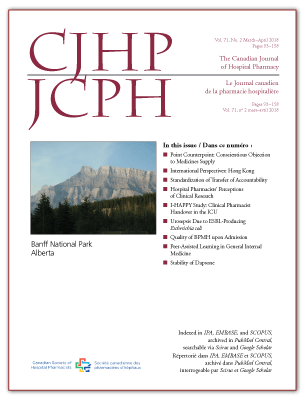Evaluation of Standardization of Transfer of Accountability between Inpatient Pharmacists
DOI:
https://doi.org/10.4212/cjhp.v71i2.1859Keywords:
transfer of accountability, standardization, policy, documentation, pharmacist, transfert de responsabilité, normalization, politique, consignation, pharmacienAbstract
ABSTRACT
Background: A compelling body of evidence supports the notion that transfer of accountability (TOA) improves communication, continuity of care, and patient safety. TOA involves the transmission and receipt of information between clinicians at each transition of care. Without a notification system alerting pharmacists to patient transfers, pharmacists’ ability to seek out and complete TOA may be hindered. A standardized policy and process for TOA, with automated workflow, was implemented at the study hospital in 2015, to ensure consistency and timeliness of documentation by pharmacists.
Objective: To evaluate pharmacists’ adherence to and satisfaction with the TOA policy and process.
Methods: A retrospective audit was conducted, using a random sample of individuals who were inpatients between June 2014 and February 2016. Transition points for TOA were identified, and the computerized pharmacy system was reviewed to determine whether TOA had been documented at each transition point. After the audit, an online survey was distributed to assess pharmacists’ response to and satisfaction with the TOA policy and workflow.
Results: Before the TOA workflow was implemented, TOA documentation by pharmacists ranged from 11% (10/93) to 43% (48/111) of transitions. Eight months after implementation of the workflow, the rate of TOA documentation was 87% (68/78), exceeding the institution’s target of 70%. Of the 32 pharmacists surveyed, most were satisfied with the TOA policy and agreed that the standardized workflow was simple to use, increased the number of TOAs provided and received, and improved the quality of completed TOAs. Respondents also indicated that the TOA workflow had improved patient care (mean score 4.09/5, standard deviation 0.64).
Conclusions: The standardized TOA policy and process were well received by pharmacists, and resulted in consistent TOA documentation and a TOA documentation rate that exceeded the institutional target.
RÉSUMÉ
Contexte : Un nombre imposant de données probantes viennent appuyer l’idée que le transfert de responsabilité (TDR) améliore la communication, la continuité des soins et la sécurité des patients. Le TDR consiste en la transmission et la réception d’information entre cliniciens à chaque transfert des soins. Sans système de notification informant les pharmaciens d’un transfert de patient, leur capacité de trouver et de réaliser un TDR pourrait être restreinte. Une politique et un processus normalisés de TDR, comprenant une automatisation du flux de travaux, ont été mis en place en 2015 dans l’hôpital à l’étude afin d’assurer que la consignation par les pharmaciens soit uniforme et opportune.
Objectif : Évaluer dans quelle mesure les pharmaciens respectent la politique et le processus de TDR, et en sont satisfaits.
Méthodes : Un audit rétrospectif a été mené à l’aide d’un échantillon aléatoire composé de patients hospitalisés entre juin 2014 et février 2016. Les points de transition pour le TDR ont été recensés et le système informatique de la pharmacie a été consulté pour déterminer si le TDR avait été consigné à chaque point de transition. Après l’audit, un sondage en ligne a été envoyé aux pharmaciens pour évaluer leurs réactions à l’égard de la politique de TDR ainsi que du flux de travaux correspondant et pour connaître leur degré de satisfaction.
Résultats : Avant la mise en place du flux de travaux associé au TDR, la fréquence de consignation du TDR par les pharmaciens variait entre 11 % (10/93) et 43 % (48/111) des transitions. Huit mois après la mise en place du flux de travaux, le taux était de 87 % (68/78), dépassant ainsi la cible de 70 % fixée par l’établissement. Parmi les 32 pharmaciens sondés, la plupart étaient satisfaits de la politique de TDR et ils estimaient que le flux de travaux normalisé était simple à suivre, qu’il augmentait le nombre de TDR reçus et fournis et qu’il améliorait la qualité des TDR menés à terme. Les pharmaciens ont aussi indiqué que le flux de travaux associé au TDR avait amélioré les soins aux patients (score moyen de 4,09/5, écart-type de 0,64).
Conclusions : La politique et le processus normalisés de TDR ont été bien reçus par les pharmaciens et ont permis d’obtenir une harmonization de la consignation du TDR et un taux de consignation du TDR qui dépassait la cible de l’établissement.Downloads
Published
Issue
Section
License
Copyright © Canadian Society of Healthcare-Systems Pharmacy.
After publication of a manuscript in the CJHP, the authors of the manuscript must obtain written permission from the CSHP (publications@cshp.ca) before reproducing any text, figures, tables, or illustrations from the work in future works of their own. If a submitted manuscript is declined for publication in the CJHP, all said rights shall revert to the authors. Please note that any forms (e.g., preprinted orders and patient intake forms) used by a specific hospital or other health care facility and included as illustrative material with a manuscript are exempt from this copyright transfer. The CJHP will require a letter from the hospital or health care facility granting permission to publish the document(s).










